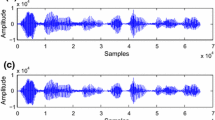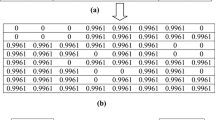Abstract
In order to solve the problems that most of the existing speech authentication algorithms can only realize tamper localization of frames, and need to the additional recovery information during tamper recovery, an encrypted speech authentication and recovery scheme based on fragile watermarking was proposed by using least significant bit method (LSB) and linear interpolation method. Firstly, a scrambling encryption algorithm based on Henon mapping is designed to encrypt and decrypt speech. Secondly, the frame number of ciphertext speech is used to construct fragile watermarking information. Finally, the LSB method is used to embed the watermarking into the fourth place after the decimal point of encrypted speech for authentication, and residial-based linear interpolation method is used to tamper recover the unauthenticated speech. The experimental results show that the proposed scheme can realize the tamper detection and location of sampling points, and the restored tampered content has good auditory quality.








Similar content being viewed by others
References
Bevinamarad, P. R., & Shirldonkar, M. S. (2020). Audio forgery detection techniques: present and past review. In 2020 4th International Conference on Trends in Electronics and Informatics (ICOEI) (pp. 613–618). IEEE.https://doi.org/10.1109/ICOEI48184.2020.9143014
Shi, C. H., Li, X. J., & Wang, H. X. (2020). A novel integrity authentication algorithm based on perceptual speech hash and learned dictionaries. IEEE Access, 8, 22249–22265. https://doi.org/10.1109/access.2020.2970093
Qian, Q., Wang, H. X., Shi, C. H., & Wang, H. (2017). An efficient content authentication scheme in encrypted speech based on integer wavelet transform. In IEEE 2016 Asia-Pacific Signal and Information Processing Association Annual Summit and Conference (APSIPA) (pp. 1–8). IEEE. https://doi.org/10.1109/APSIPA.2016.7820814
Hu, H. T., & Lee, T. T. (2019). Hybrid blind audio watermarking for proprietary protection, tamper proofing, and self-recovery. IEEE Access, 7, 180395–180408. https://doi.org/10.1109/access.2019.2958095
Meng, X. B., Li, C., & Tian, L. H. (2019). Detecting audio splicing forgery algorithm based on local noise level estimation. In 2018 5th International Conference on Systems and Informatics (ICSAI) (pp. 861–865). IEEE.https://doi.org/10.1109/ICSAI.2018.8599318
Wang, S. B., Yuan, W. T., Wang, J. M., & Unoki, M. (2019). Detection of speech tampering using sparse representations and spectral manipulations based information hiding. Speech Communication, 112, 1–14. https://doi.org/10.1016/j.specom.2019.06.004
Wang, Z., Wang, J., Zeng, C., Min, Q., Tian, Y., & Zuo, M. (2018). Digital audio tampering detection based on ENF consistency. In 2018 International Conference on Wavelet Analysis and Pattern Recognition (ICWAPR) (pp. 209–214). IEEE. https://doi.org/10.1109/ICWAPR.2018.8521378
Li, C., Sun, Y., Meng, X., & Tian, L. (2019). Homologous audio copy-move tampering detection method based on pitch. In 2019 IEEE 19th International Conference on Communication Technology (ICCT) (pp. 530–534). IEEE.https://doi.org/10.1109/ICCT46805.2019.8947002
Yan, Q., Yang, R., & Huang, J. (2019). Robust copy–move detection of speech recording using similarities of pitch and formant. IEEE Transactions on Information Forensics and Security, 14(9), 2331–2341. https://doi.org/10.1109/TIFS.2019.2895965
Esmaeilbeig, Z., & Ghaemmaghami, S. (2018). Compressed video watermarking for authentication and reconstruction of the audio part. In 2018 15th International ISC (Iranian Society of Cryptology) Conference on Information Security and Cryptology (ISCISC) (pp. 1–6). ISC. https://doi.org/10.1109/ISCISC.2018.8546897
Liu, Z., Huang, J., & Sun, X. (2017). A security watermark scheme used for digital speech forensics. Multimedia Tools and Applications, 76, 9297–9317. https://doi.org/10.1007/s11042-016-3533-9
Wang, J., & He, J. (2017). A speech content authentication algorithm based on a novel watermarking method. Multimedia Tools and Applications, 76, 14799–14814. https://doi.org/10.1007/s11042-016-4027-5
Wang, J., Liu, Z., He, J., & Qi, C. (2015). An authentication and recovery scheme for digital speech signal based on DWT. In 2015 International Workshop on Digital Watermarking (Vol. 9569, pp. 206–219). Springer. https://doi.org/10.1007/978-3-319-31960-5_17
Qian, Q., Wang, H., Sun, X., et al. (2018). Speech authentication and content recovery scheme for security communication and storage. Telecommunication Systems, 67, 635–649. https://doi.org/10.1007/s11235-017-0360-x
Menendez-Ortiz, A., Feregrino-Uribe, C., Garcia-Hernandez, J., et al. (2017). Self-recovery scheme for audio restoration after a content replacement attack. Multimedia Tools and Applications, 76(12), 14197–14224. https://doi.org/10.1007/s11042-016-3783-6
Menendez-Ortiz, A., Feregrino-Uribe, C., & Garcia-Hernandez, J. (2018). Self-recovery scheme for audio restoration using auditory masking. PLoS ONE, 13(9), e0204442. https://doi.org/10.1371/journal.pone.0204442
Brajović, M., Stanković, I., Daković, M., & Stanković, L. (2021). The DCT domain sparsity-assisted detection and recovery of impulsively disturbed samples. Multimedia Tools and Applications, 80(4), 6221–6234. https://doi.org/10.1007/s11042-020-09998-w
Lu, W., Chen, Z., Li, L., et al. (2018). Watermarking based on compressive sensing for digital speech detection and recovery. Sensors, 18(7), 2390. https://doi.org/10.3390/s18072390
Liu, Z. H., Sun, F., & Qi, C. D. (2018). An authentication and recovery algorithm based on DWT. Journal of the China Railway Society, 40(3), 76–81. https://doi.org/10.3969/j.issn1001-8360.2018.03.011 in Chinese.
Liu, Z. H., Luo, D., Huang, J. W., et al. (2017). Tamper recovery algorithm for digital speech signal based on DWT and DCT. Multimedia Tools and Applications, 76(10), 12481–12504. https://doi.org/10.1007/s11042-016-3664-z
Qian, Q., Wang, H. X., Abdullahi, S. M., Wang, H., & Shi, C. H. (2016). Speech authentication and recovery scheme in encrypted domain. In 2016 International Workshop on Digital Watermarking (Vol. 10082, pp. 46–60). Springer. https://doi.org/10.1007/978-3-319-53465-7_4
Fan, M. Q. (2020). A source coding scheme for authenticating audio signal with capability of self-recovery and anti-synchronization counterfeiting attack. Multimedia Tools and Applications, 79(1–2), 1037–1055. https://doi.org/10.1007/s11042-019-08095-x
Gomez-Ricardez, J. J., & Garcia-Hernandez, J. J. (2019). An audio self-recovery scheme that is robust to discordant size content replacement attack. In 2018 IEEE 61st International Midwest Symposium on Circuits and Systems (MWSCAS) (pp. 825–828). IEEE. https://doi.org/10.1109/mwscas.2018.8623934
Ma, Y., Hong, H., Zhao, H., Li, H., Gu, C., & Zhu, X. (2019). Speech recovery based on auditory radar and webcam. In 2019 IEEE MTT-S International Microwave Biomedical Conference (IMBioC) (pp. 1–3). IEEE. https://doi.org/10.1109/imbioc.2019.8777840
Fakhar Firouzeh, F., Chinneck, J. W., & Rajan, S. (2020). Maximum feasible subsystem algorithms for recovery of compressively sensed speech. IEEE Access, 8, 82539–82550. https://doi.org/10.1109/access.2020.2990155
Al-hazaimeh, O. M. (2021). A new speech encryption algorithm based on dual shuffling Hénon chaotic map. International Journal of Electrical and Computer Engineering (IJECE), 11(3), 2203–2210. https://doi.org/10.11591/ijece.v11i3.pp2203-2210
Wang, D., Zhang, X. W. (2015). Thchs-30: A free Chinese speech corpus. arXiv preprint arXiv:1512.01882
Zhang, Q., Zhou, L., Zhang, T., et al. (2019). A retrieval algorithm of encrypted speech based on short-term cross-correlation and perceptual hashing. Multimed. Tools Appl., 78(13), 17825–17846. https://doi.org/10.1007/s11042-019-7180-9
Zhang, Q., Li, Y., & Hu, Y. (2021). A retrieval algorithm for encrypted speech based on convolutional neural network and deep hashing. Multimedia Tools and Applications, 80(3), 1201–1221. https://doi.org/10.1007/s11042-020-09748-y
Zhang, Q., Zhang, D., & Xu, F. (2021). An encrypted speech authentication and tampering recovery method based on perceptual hashing. Multimedia Tools and Applications, 80(23), 24925–24948. https://doi.org/10.1007/s11042-021-10905-0
Acknowledgements
The authors also gratefully acknowledge the helpful comments and suggestions of the reviewers, which have improved the presentation.
Funding
This work is supported by the National Natural Science Foundation of China (Nos. 61862041, 61363078).
Author information
Authors and Affiliations
Corresponding author
Ethics declarations
Conflict of interest
The authors declare that they have no conflict of interest.
Additional information
Publisher's Note
Springer Nature remains neutral with regard to jurisdictional claims in published maps and institutional affiliations.
Rights and permissions
Springer Nature or its licensor (e.g. a society or other partner) holds exclusive rights to this article under a publishing agreement with the author(s) or other rightsholder(s); author self-archiving of the accepted manuscript version of this article is solely governed by the terms of such publishing agreement and applicable law.
About this article
Cite this article
Zhang, Qy., Xu, Fj. Encrypted speech authentication and recovery scheme based on fragile watermarking. Telecommun Syst 82, 125–140 (2023). https://doi.org/10.1007/s11235-022-00976-1
Accepted:
Published:
Issue Date:
DOI: https://doi.org/10.1007/s11235-022-00976-1




